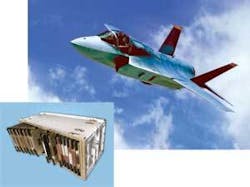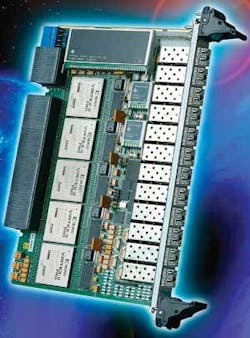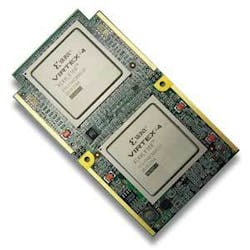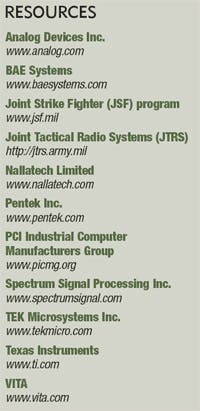COTS suppliers in the defense industry collaborate with systems integrators to further electronic-warfare and signals-intelligence technologies.
By Courtney E. Howard
Electronic-warfare (EW) and signals-intelligence (SIGINT) technologies are increasingly important to U.S. Department of Defense (DOD) and Department of Homeland Security efforts in the war against terrorism. After all, EW and SIGINT hardware and software enable warfighters to locate analog and digital signals, from which they glean and exploit critical information.
Another option, however, is to deny the enemy access to that signal.
In the Middle East, signal-jamming techniques, such as countering with electronics emissions, thwart the growing trend of electronic attack. For instance, work is in progress to detect and disable cell-phone transmissions through jamming to prevent them from triggering improvised explosive devices (IEDs).
Many people associate SIGINT primarily with aircraft, but today it is in wide use across land, sea, air, and space. It is a critical area in surface-ship defense, for example, concerning innovations such as anti-cruise-missile identification, target acquisition, weather forecasting and analysis, and more. SIGINT also plays a role in ground-based vetronics for applications such as identifying friend and foe, situational awareness, and threat detection from other classes of vehicles.
Whatever the desired function or platform, EW and SIGINT are the focus of many industry programs, and technology companies are emphasizing integrated, reconfigurable, multimission solutions that balance the latest COTS hardware with specialized, full-featured software and development tools.
Forward-looking flexibility
When it comes to EW and SIGINT, the options are many. After an antenna, radar system, or other device acquires a signal flow, the system converts the signal from an analog to a digital form and sends it to a processing engine. From there, it may go to a disk for storage, into a headphone for operator listening, or to another station for further processing.
“The signal could be manipulated, upconverted, and rebroadcast to an antenna to complete the communication loop,” adds Rodger Hosking, vice president of Pentek Inc. in Upper Saddle River, N.J. “It could range from a telemetry loop, where you bring a signal down from a satellite and send it back up, to a radar system. You could receive a jet’s radar pulse, twist it a little bit, and return a radar signal that confuses him, making him think your plane is 1000 miles off in a different direction.”
These sample workflows can be accomplished with various data-conversion solutions-including analog-to-digital (A-D) and digital-to-analog (D-A) converters and such software radio products as digital downconverters and digital upconverters-that perform a digital frequency translation on incoming signals. Once the signal comes down to base band, processing and software-defined radio functions take over using a digital signal processor (DSP), a general-purpose processor (GPP) like a PowerPC or a Pentium, or a field-programmable gate array (FPGA).
Acknowledging advancements
EW and SIGINT technology continues to advance at a steady pace, despite some cutbacks in funding. In the interest of doing more with less, product innovations center on commercial-off-the-shelf (COTS) hardware, building a common platform for use across all services, and reconfiguring and upgrading systems with software.
Two major initiatives today, the Joint Strike Fighter (JSF) program and Joint Tactical Radio System (JTRS), share these goals.
“Those in the armed forces, under the JTRS program especially, are interested in standardizing and normalizing all the hardware for all the different types of radio signals that they need to receive and transmit to use a common hardware platform that is configurable,” Hosking says. “It would enable users to have one piece of hardware that’s adaptable to a lot of different kinds of communication that they need. JTRS, which is a huge initiative, started with good aims: to have the hardware radio platforms be completely independent of the software that goes into them, to allow radios to receive and transmit different types of signals, and to normalize and standardize the interfaces.”
It is a global trend, in fact. Stephen Lynas, vice president of marketing for Nallatech Limited in Glasgow, Scotland, notes the increased use and effectiveness of software and development tools on today’s worldwide defense market. This is a technology trend that Lynas anticipates will become more widespread. At Nallatech, engineers focus on designing modular, scalable systems that can acquire inputs from different types of sensors, so that customers can reap the benefits of their investment and the experience they have with the products into the future.
All-in-one challenges
One would think there is little downside to such a proposition. Reusing a hardware investment and reconfiguring it according to a user’s needs sounds like a promising solution to a dwindling defense budget. Alas, it is not without caveats.
For starters, when a device needs to be all things to all people, it suffers from an efficiency standpoint. “Taking advantage of the signal-processing power of an FPGA, for example, is a wonderful thing to try to do, but an FPGA inherently is not software friendly and it tends to be most efficient when dedicated to performing a particular task,” Hosking admits. “It involves taking something that’s really good at doing any one thing at a time and trying to make it do all things at any time-it’s difficult.”
Another challenging aspect of system design and integration today is the size, weight, and power proposition. To date, the War on Terror worldwide has heavily involved urban warfighting, bringing about the need for small, often unmanned and weapons-bearing platforms.
Executives at Nallatech and BAE Systems in Nashua, N.H., have witnessed a growing emphasis on the miniaturization of technology. “Our customers are looking to apply technologies to smaller footprints and application envelopes that were much more difficult to accommodate in the past,” says Ed Hennessy, vice president of North American operations for Nallatech Inc. in Eldersburg, Md. “Miniaturization of various systems is taking place through advances in packaging and form factor at the engineering and technical level.”
Systems also are more technologically and physically dense and complex, incorporating a wealth of smaller components-each with its own coordinating software program, driver, libraries, or development tools-than in decades, or even years, past.
“We used to have two or three hardware engineers for every software engineer 20 years ago,” Hosking recalls. “Now it’s just the reverse-we have two or three software engineers for each hardware engineer.” This trend speaks not only to the ever-increasing amount of software solutions required by EW and SIGINT systems today, but also to the growing difficulty in developing software tools that are easy to use by customer standards. As a result, in terms of a system integrator promising to deliver a client’s system on a certain date, one of the most risky things to predict is how long it will take to write the necessary software.
The JTRS program has been progressing slower than originally anticipated, likely due to issues with its software communication architecture (SCA), an open-architectural framework, and programmable radio-system definition standard proposed by the JTRS Joint Program Office (JPO).
In trying to make general-purpose hardware efficient enough to be practical, Hosking says, compromises have been made, and they tend to make the hardware less generic and more specific. “It’s one of the things the government was trying to get away from: a company like Rockwell Collins, for example, releasing a radio that does a job really well, but the only place you can get it is Rockwell Collins for a lot of money because it’s unique, proprietary, powerful, and only Rockwell Collins knows exactly how it works,” he says.
“Having each vendor in the military radio community open up architectures and use a common platform so that the government can choose freely among them puts them all on a level playing field where they have to compete a lot more for business,” Hosking says. “Do I really want to help define the standards that are going to ultimately undo my profit? Your competitive edge can be eroded that way; you don’t necessarily want to share and give away to every other competitor out there intellectual property that you’ve developed. And, the very mission of trying to make hardware be so generic that it can do any job makes it less efficient at doing any one job. Both of those factors have made the initiative move a bit more slowly than people thought it would.”
All is not lost, however. Challenges such as these can be overcome through industry-wide cooperation. Members of the defense community should continue their active involvement with standards committees.
“There’s nothing like a standard that everyone can rally around,” Hosking says. “That’s what government executives need to feel comfortable in taking a technology step on the way from where they are to where they want to be. They can do that with a standard that many vendors claim support of, allegiance to, and compliance with-that’s what needs to be done.”
COTS capabilities
In keeping with the open-architecture approach, EW and SIGINT products and technologies lend well to the use of COTS components acquired from the computer and telecommunications industries. In fact, Hosking says, “the cell phone is a perfect example of a software-defined radio that has been exploited with a huge commercial market to get more and more functionality and power in a smaller physical space and use less and less of the frequency spectrum.”
In previous decades, engineers often opted to design and develop their own printed-circuit boards for defense projects. “It wasn’t as much of an investment and it wasn’t quite as much risk as it is today,” Hosking recalls. “But as devices become more mechanically sophisticated going forward, the job of doing board-level design is becoming more and more difficult.”
Now considerable time and effort go into the printed circuit-board layout, design, packaging, wiring, heat sinks, use of ICs in high-density ball-grid arrays, and the precise assembly and soldering techniques required. More government contractors are, as a result, investing in COTS products rather than spending two years developing them. After all, there is a chance that the homespun parts that design into a project will be old or obsolete by the time the project is completed.
Customers now are frequently asking suppliers to certify COTS-based products for their target platforms and specific application environments. A COTS supplier might, for example, comply with and provide certification for DO-178B, a well-defined specification for avionics use within the military. “It means that before customers apply these technologies in the real world for deployment and production, COTS suppliers or the defense contractors they work with collaboratively will have to start establishing that the products are certifiable according to certain government standards and specs,” Hennessy explains.
This trend is contributing to COTS adoption not only moving more deeply into the defense and military segment, but also meeting with challenges and obstacles given that not all suppliers are sufficiently experienced, knowledgeable, or prepared to make that level of investment.
“COTS is hot so the demand is high and suppliers expect success, but it’s a very demanding, sophisticated, and complex business,” Hennessy says. “SIGINT and EW are two of the most challenging areas for COTS suppliers when they look at the potential of their technologies being deployed. For many COTS vendors, the lifecycle of their products is 18 to 24 months; a defense contractor’s program element usually has a life of 7 to 15 years; and the government uses platforms such as the F-22, F-16, or a major ship for 40 to 50 years. It’s a tough balancing act when you think of these three entities trying to manage things from lifecycle and obsolescence management standpoints.”
One component that is perhaps unscathed by the obsolescence issue is the FPGA. Roughly three years ago, the industry began replacing traditional technologies, such as general-purpose microprocessors and DSPs, with COTS FPGA-based technology, which offered affordability, performance, and advantages in size, weight, and power. Widespread FPGA adoption continues-as the industry requirements for information processing and high performance grow, FPGAs are being linked together into multiprocessing systems.
“Field-programmable devices can be adapted to perform different tasks by the end user, either in situ or in the lab, so that provides flexibility for the company or person in the field,” Lynas says. “Because the user can program and reconfigure the FPGA, it is less susceptible to obsolescence than something based on a microprocessor or a DSP. As suppliers revise these technologies, they sometimes change instruction sets, which can obsolete products out in the field.”
FPGAs and ASICs are not new to defense customers, Hennessy says. Nallatech customers, for example, have been creating proprietary designs with FPGA and ASIC technology for two or three decades. Yet in a new turn of events, COTS suppliers increasingly are harnessing this raw technology to develop platform solutions specific to their customers’ application challenges. In any case, the future of COTS adoption in the EW and SIGINT space looks bright.
Products of the future
When it comes to the hardware and software tools being offered by COTS vendors in the EW and SIGINT space today, customers are openly voicing their wants and needs and, as a result, steering the technology accordingly.
COTS suppliers to the defense industry are noting a desire for products that are easier to use, especially when it comes to FPGAs. It’s an ongoing challenge to make FPGAs more user friendly, in fact.
“You can imagine there’d be a big initiative for customers to want to push a button and get an instantly optimized FPGA configuration for anything they might want to do,” Hosking says. “Tool vendors are approaching that, some of them more successfully than others. What it comes down to is everybody wants to buy a solution at a higher level-as high as they can get-to minimize time to market, development cost, and risk.”
Companies like Pentek are unveiling design kits and other tool sets to aid in the quick and uncomplicated installation of the clients’ intellectual property onto products. For example, Pentek’s GateFlow IP Core Library is a collection of functions and algorithms-including fast-Fourier transforms, digital upconverters, digital downconverters, and pulse compression algorithms-that have been optimized to run in a particular class of FPGA that many customers need. “It saves the customer from having to sit down and develop this same algorithm and optimize, tweak, test, and modify it and so forth,” Hosking says.
Defense customers are also putting an emphasis on sensor-to-shooter technology, which is a high priority of the DOD. Systems designers aim to reduce complexity, improve effectiveness, and reduce the time between identifying a threat and taking action against a target. “It is a key initiative in which billions of dollars are being invested today,” Hennessy says.
Hosking also notes a strong migration among Pentek’s customer base toward connecting system components via switched-serial gigabit fabric. At the same time, Nallatech users are requesting more of an integrated subsystem to meet application requirements as they combine a range of different technologies and operating system environments in an overall solution. And the industry overall is more cognizant of and proactive about the need for periodic technology upgrades to stave off the threat of obsolescence.
null










